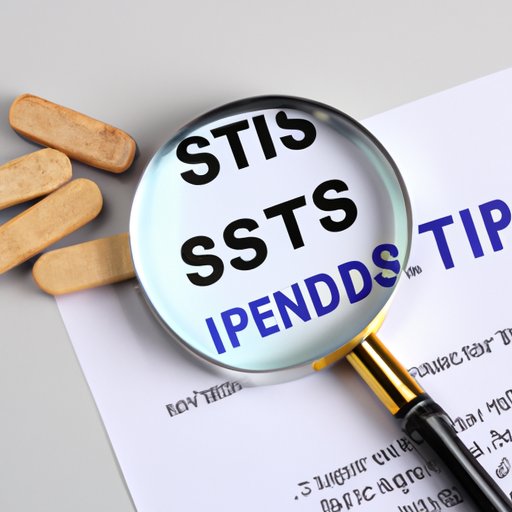
Introduction
Sexually transmitted diseases (STDs), also known as sexually transmitted infections (STIs), are a common health concern worldwide. According to the World Health Organization (WHO), an estimated one million people contract an STD every day, and many of these cases go undiagnosed. Knowing how to identify the signs and symptoms of STDs can help individuals protect their own health and that of their sexual partners. In this article, we will cover the ultimate guide to understanding and identifying STDs.
The Ultimate Guide: Signs and Symptoms of STDs
STDs are infections that spread through sexual activities, including vaginal, anal, and oral sex. Most STDs are caused by bacteria, viruses, or parasites. Depending on the type of STD, the symptoms may vary, and some people may not experience any symptoms at all. Common signs and symptoms of STDs include:
- Pain or burning during urination
- Sores, bumps, or rashes on or around the genital area
- Discharge from the penis or vagina
- Unusual vaginal bleeding or spotting
- Pain during sex
- Itching or burning around the genitals
- Flu-like symptoms, such as fever, fatigue, and swollen lymph nodes
It’s important to note that not all STDs cause symptoms, and some symptoms may not appear for weeks or even months after exposure. That’s why it’s crucial to get tested regularly if you are sexually active.
Do You Have an STD? Here’s How to Check and What to Do
Getting tested for STDs is a straightforward process. Healthcare professionals can conduct STD testing through blood tests, urine tests, or swabs of the infected area. Some tests may require multiple samples taken a few weeks apart to ensure accuracy.
If you test positive for an STD, don’t panic. Most STDs are treatable with medications such as antibiotics. Your healthcare provider will discuss your treatment options and provide you with guidance on how to manage the infection. It’s important to follow up with all recommended treatments to ensure a full recovery.
If you are sexually active, you should inform your sexual partners of your status as soon as possible. This is important not only for their health but also to prevent further spread of the infection.
How to Spot an STD: Warning Signs You Can’t Ignore
While some STDs may present with similar symptoms, some have unique identifying signs that can help you determine the specific infection. For example:
- Genital herpes often presents with tingling sensations on the genitals or around the mouth, followed by painful blisters or sores.
- Gonorrhea can cause painful urination, yellow or green discharge from the penis or vagina, and sore throat.
- Chlamydia may not show any symptoms but can result in infertility if left untreated.
- Syphilis can cause a painless sore or ulcer on the genitals or mouth.
Untreated STDs can lead to long-term health problems, such as infertility, chronic pain, and increased risk of HIV transmission. If you experience any concerning symptoms, it’s essential to see a healthcare provider as soon as possible.
Quick Guide to Identifying Common STDs and Taking Action
Here is a brief overview of the most common STDs and their symptoms:
- Chlamydia: Discharge from the penis or vagina, burning and itching around the genitals, painful urination, lower abdominal pain.
- Gonorrhea: Yellow or green discharge from the penis or vagina, painful urination, sore throat.
- Genital Herpes: Tingling or itching sensations around the genitals or mouth, painful blisters or sores that may break open and bleed.
- Human papillomavirus (HPV): Warts or bumps that may be flesh-colored or have black dots in clusters around the genitals, anus, or mouth.
- Syphilis: Painless sore or ulcer on the genitals or mouth, rash on the palms of the hands or soles of the feet, flu-like symptoms.
If you experience any of these symptoms, it’s essential to get tested and treated as soon as possible. Treatment options may include antibiotics or antiviral medications. It’s also important to avoid sexual activity until treatment is complete and follow up with your healthcare provider to ensure a full recovery.
STDs 101: What Everyone Should Know and Watch Out For
STDs are primarily spread through sexual activity, including vaginal, anal, and oral sex. However, some STDs can also be spread through skin-to-skin contact, such as genital warts and herpes. Anyone who is sexually active can contract an STD, regardless of age, gender, or sexual orientation. However, certain factors can increase the risk of contracting an STD, such as:
- Having multiple sexual partners
- Engaging in unprotected sex
- Starting sexual activity at an early age
- Having a history of STDs
Practicing safe sex by using condoms and other barriers can significantly reduce the risk of contracting an STD. Getting vaccinated for HPV and hepatitis B can also reduce the risk of these infections. Regular testing, even if you don’t have symptoms, is also important to ensure early detection and treatment of any potential infections.
Conclusion
Knowing how to identify the signs and symptoms of STDs is crucial for protecting your own health and that of your sexual partners. If you experience any concerning symptoms or suspect you may have an STD, it’s important to see a healthcare provider as soon as possible. Practicing safe sex and getting tested regularly can also help prevent the spread of STDs and ensure early detection and treatment. Don’t let stigma or fear prevent you from taking care of your sexual health.





